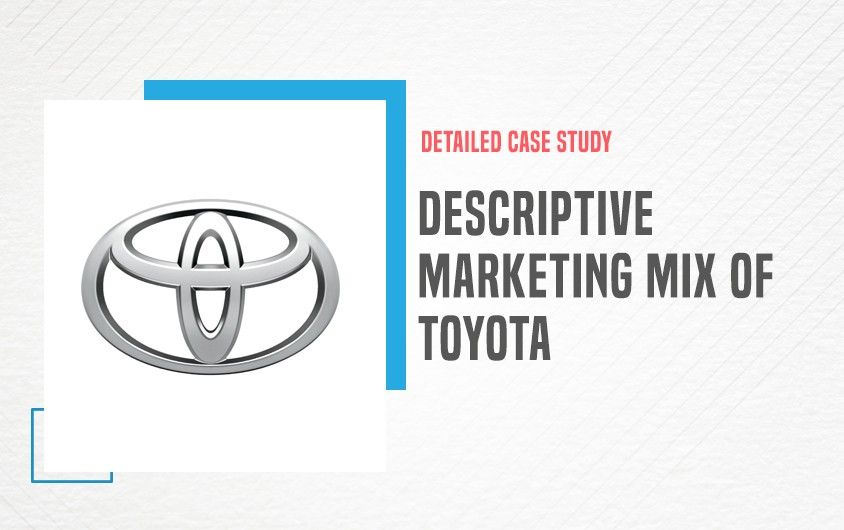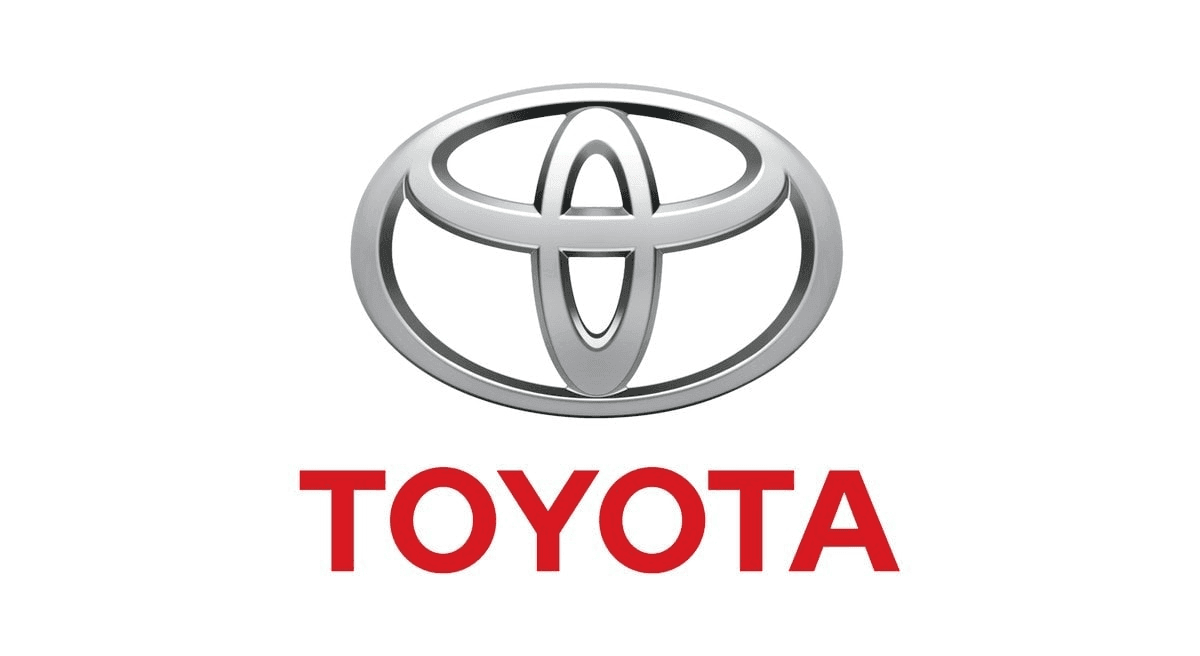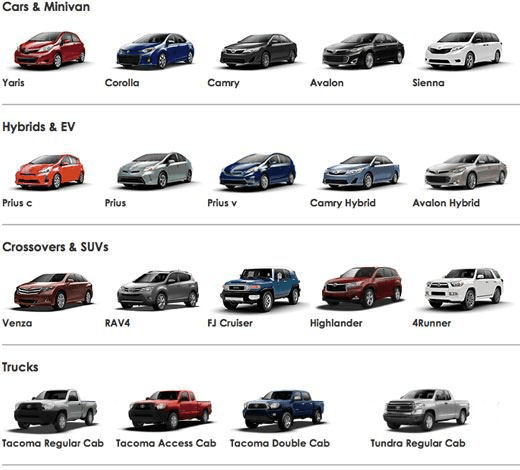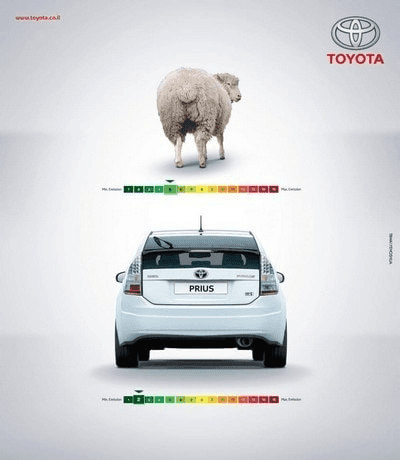Join an online Q&A session with the Director of Student Success to explore what your experience as an IIDE student will be like. Register Now.

Updated on Aug 9, 2025
Share on:
About Toyota:

Toyota was founded in the year 1937 by Kiichiro Toyoda in Toyota, Aichi, Japan. The products of the brand include Automobiles, Luxury Vehicles, Commercial Vehicles, and Engines under five brands including the Toyota Brand, Hino, Lexus, Ranz, and Daihatsu.
With their innovative hybrid and environmental technology, they are one of the leading brands in the automotive industry. It has a market share of 13.5% in the world. Toyota is the largest manufacturer in the world followed by Volkswagen Group, Hyundai, and General Motors.
They are now trying to develop a fuel cell technology to incorporate in their vehicles. Toyota’s brand is correlated with quality, durability, safety, innovation, reliability, and sustainability.
Now that we have known about the company let us see the marketing mix of Toyota.
Marketing mix of Toyota
The marketing mix is the technique used by a company to promote its products. It is categorized into 4p’s which are price, product, promotion, and place.
Toyota uses its marketing mix to interact with its target customers. It has a wide range of markets to target in terms of consumer preferences, regional and local market conditions. It has adapted its marketing mix to these different customer preferences in the market.
Its continuous growing success shows how well the company has implemented its marketing mix.
Let us start with its marketing mix by first looking at the product strategy of Toyota.
1. Toyota’s Products Strategy (Product Mix)

With the market diversified demand for different preferences, Toyota has a diverse set of products to serve all types of customers. These are some of the products that the company provides:
- Toyota automobiles
- Lexus automobiles
- Welcab series
- Marine products
- Spare parts and accessories
- Engines
There is a variety of products for different people for example- Lexus automobiles are luxury products, whereas the Welcab series are automobiles specially modified for the elderly and people with disabilities. It also manufactures yachts, engines, spare parts, accessories for automobiles and marine products.
Now let us see the Place strategy of Toyota.
2. Toyota’s Place/Distribution Strategy (Place Mix)
Product mix determines the place where the products are made available for the customers to access them. Making products available for customers is an important part of a business. Toyota has two main distribution strategies:
- Dealerships
- Retailers
Most of its transactions happen with its dealerships. However, there are retailers like auto supple stored also who sell its products like spare parts and accessories. On these facts, we can see that the company depends more on dealerships to sell its products.
Let us now see the Promotional strategy of Toyota.
3. Toyota’s Promotion Strategy(Promotional Mix)

Toyota has covered all the promotional tactics in their promotional strategy. They market their products byways of billboards, newspapers, T.V, social media platforms(Youtube, Twitter, Instagram, etc), and websites.
These are some of the promotion activities used by Toyota :
- Personal selling
- Advertising
- Public relations
- Sales promotion
- Direct selling
They use personal relationships to promote their products like Green Program for environmental initiatives, an initiative to reduce greenhouse gas emissions, etc.
Toyota uses catchy slogans for the brand and endorses celebrities as brand ambassadors creating a brand recall for customers. The current brand ambassador of the company is Ayushmann Khurrana.
It uses personal selling by sales personnel, they personally promote their products to potential buyers.
Lastly, we will see the Pricing Strategy of Toyota.
4. Toyota’s Price Strategy (Price Mix)
Toyota has been providing affordable price vehicles to its customers. They allow credits to their customers on low-interest rates to make more profit.
Its price strategy depends on the competition, segment, geography, and demand. They have a flexible pricing strategy depending on the change in market conditions, and competitors.
They use two pricing strategies which are:
- Market-oriented pricing
- Value-based pricing
However, the firm also uses the value-based pricing strategy, which sets prices based on the actual and perceived value of the product. The company uses value-based pricing for high-end or more expensive products, such as the Prius and Lexus cars.


Learn Digital Marketing for FREE


Conclusion
Toyota is a company that gives some of the best value products to its customers in terms of its pricing and quality. It has different products for the different requirements of its customers from value-based pricing to luxury products.
It has a wide range of products for its customers to choose from they have made their products available for all types of preferences.
They make their products available for the customers in all possible ways. May it be dealers or personal selling they have it covered.
They have been using all types of product promotion techniques in the market and adapted to the new digital world by digitally promoting their products.
Wasn’t it interesting to know Toyota’s marketing mix? Learn how to market your brand online using digital marketing check our website for more information.
Also, you can check out Free Digital Marketing Masterclass by IIDE to understand what digital marketing is all about.
Thank you for reading the blog. We hope that you came to know something new about the Toyotas 4 Ps Marketing Mix from this blog. Let us know your thoughts in the comments below.If you like our blog then do share it with your friends and explore more of our blogs.
Want to Know Why 2,50,000+ Students Trust Us?
Dive into the numbers that make us the #1 choice for career success

MBA - Level
Post Graduate in Digital Marketing & Strategy
Best For
Fresh Graduates
Mode of Learning
On Campus (Mumbai & Delhi)
Starts from
Jan 5, 2026
Duration
11 Months
Live & Online
Advanced Online Digital Marketing Course
Best For
Working Professionals
Mode of Learning
Online
Starts from
Jan 5, 2026
Duration
4-6 Months

Online
Professional Certification in AI Strategy
Best For
AI Enthusiasts
Mode of Learning
Online
Duration
5 Months

Offline
Undergraduate Program in Digital Business & Entrepreneurship
Best For
12th Passouts
Mode of Learning
On Campus (Mumbai)
Duration
3 Years
Recent Post
Aditya Shastri leads the Business Development segment at IIDE and is a seasoned Content Marketing expert. With over a decade of experience, Aditya has trained more than 20,000 students and professionals in digital marketing, collaborating with prestigious institutions and corporations such as Jet Airways, Godrej Professionals, Pfizer, Mahindra Group, Publicis Worldwide, and many others. His ability to simplify complex marketing concepts, combined with his engaging teaching style, has earned him widespread admiration from students and professionals alike.
Aditya has spearheaded IIDE’s B2B growth, forging partnerships with over 40 higher education institutions across India to upskill students in digital marketing and business skills. As a visiting faculty member at top institutions like IIT Bhilai, Mithibai College, Amity University, and SRCC, he continues to influence the next generation of marketers.
Apart from his marketing expertise, Aditya is also a spiritual speaker, often traveling internationally to share insights on spirituality. His unique blend of digital marketing proficiency and spiritual wisdom makes him a highly respected figure in both fields.